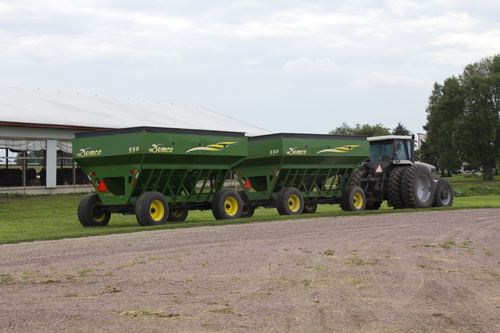Farm safety is always an important discussion topic, but sometimes we forget about farm safety when machinery leaves the farm to travel on public roads. Tractor and machinery traffic has risen now that the weather has begun to cooperate. Although the number of accidents involving farm machinery and vehicles is relatively small, these accidents are five times as likely to cause a fatality than any other type of accident, according to Iowa State University Extension. As drivers of both farm machinery and non farm vehicles, we must all remind ourselves to safely share the roads this growing season.

Maintain lights and warning signs
Keep a slow moving vehicle (SMV) sign on machinery, and make sure it is not faded and worn. Check that all lights are working and clear of debris, and be aware of the lighting and marking suggestions from the American Society of Agricultural Engineers. This link has info on lighting, marking, and where to mount a SMV sign.
Make intentions clear
Use turn signals or hand signals; you're breaking the law if you don't. When driving down the road, use all of the road without crossing the centerline. Traveling on the shoulder or to the far right of the road causes drivers to be confused, says the University of Wisconsin Center for Agricultural Safety and Health. Most accidents occur when farm machinery slows down to turn left and is side swiped by a passing vehicle or when a vehicle runs into the back of an implement; both of which could be avoided if both parties are aware of signals.
Be aware
When driving a vehicle on the same road as farm machinery it is important to also take precautions. Watch for turn signals, and do not pass unless in a passing zone. Look for driveways or fields that the tractor may be turning into. Don't be impatient; the Oregon Department of Transportation says that slowing to 20 miles per hour for two miles delays the trip only six minutes, about the time it takes to wait at two stoplights. Be aware that, like semis, most drivers in tractors or other machinery cannot see you if you following too close.
Contact your local extension offices to get more information on local regulations involving machinery traveling on public roads. Safe driving!

Maintain lights and warning signs
Keep a slow moving vehicle (SMV) sign on machinery, and make sure it is not faded and worn. Check that all lights are working and clear of debris, and be aware of the lighting and marking suggestions from the American Society of Agricultural Engineers. This link has info on lighting, marking, and where to mount a SMV sign.
Make intentions clear
Use turn signals or hand signals; you're breaking the law if you don't. When driving down the road, use all of the road without crossing the centerline. Traveling on the shoulder or to the far right of the road causes drivers to be confused, says the University of Wisconsin Center for Agricultural Safety and Health. Most accidents occur when farm machinery slows down to turn left and is side swiped by a passing vehicle or when a vehicle runs into the back of an implement; both of which could be avoided if both parties are aware of signals.
Be aware
When driving a vehicle on the same road as farm machinery it is important to also take precautions. Watch for turn signals, and do not pass unless in a passing zone. Look for driveways or fields that the tractor may be turning into. Don't be impatient; the Oregon Department of Transportation says that slowing to 20 miles per hour for two miles delays the trip only six minutes, about the time it takes to wait at two stoplights. Be aware that, like semis, most drivers in tractors or other machinery cannot see you if you following too close.
Contact your local extension offices to get more information on local regulations involving machinery traveling on public roads. Safe driving!








